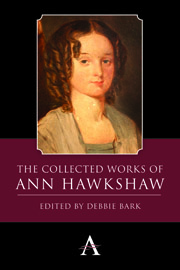Book contents
- Frontmatter
- Contents
- Preface and Acknowledgements
- Biographical Introduction
- 1842: ‘Dionysius the Areopagite’, with Other Poems
- 1843: Life's Dull Reality
- 1847: Poems for My Children
- 1854: Sonnets on Anglo-Saxon History
- 1871: Cecil's Own Book
- Appendix A
- Appendix B
- Bibliography
- Index of Titles
- Index of First Lines
1842: ‘Dionysius the Areopagite’, with Other Poems
Published online by Cambridge University Press: 05 May 2014
- Frontmatter
- Contents
- Preface and Acknowledgements
- Biographical Introduction
- 1842: ‘Dionysius the Areopagite’, with Other Poems
- 1843: Life's Dull Reality
- 1847: Poems for My Children
- 1854: Sonnets on Anglo-Saxon History
- 1871: Cecil's Own Book
- Appendix A
- Appendix B
- Bibliography
- Index of Titles
- Index of First Lines
Summary
‘Dionysius the Areopagite’, with Other Poems was published in November 1842 in London by Jackson & Walford, and in Manchester by Simms & Dinham. The collection was favourably received and reviewed. The title poem retells the biblical story of Dionysius, an elected member of the Areopagus whose conversion to Christianity in light of St Paul's teaching is briefly mentioned in the New Testament (Acts I7:34). Although the poem's opening sections are loosely based on the biblical account of St Paul's teaching in Athens, the majority of the poem is an imaginative reconstruction of Dionysius's personal journey towards Christianity and his decision to choose the Christian faith over romantic love. Through the scriptural figure of Dionysius the Areopagite Hawkshaw explores doctrines of Protestantism, as she objectifies mid-nineteenth-century challenges to religious faith by looking back to the persecution of early Christians in the period shortly after the crucifixion. By challenging the account of Christian persecution given by eighteenth-century historian Edward Gibbon (1737—94) in The History of the Rise and Fall of the Roman Empire (6 vols, 1776—89), Hawkshaw uses the struggle between paganism and the emergent Christian church in Rome as a paradigm for the move away from the High Church orthodoxy that she observes in mid-nineteenth century Britain.
Although a religious poem, ‘Dionysius the Areopagite’ is not a work of pious didacticism.
- Type
- Chapter
- Information
- The Collected Works of Ann Hawkshaw , pp. 1 - 104Publisher: Anthem PressPrint publication year: 2014



